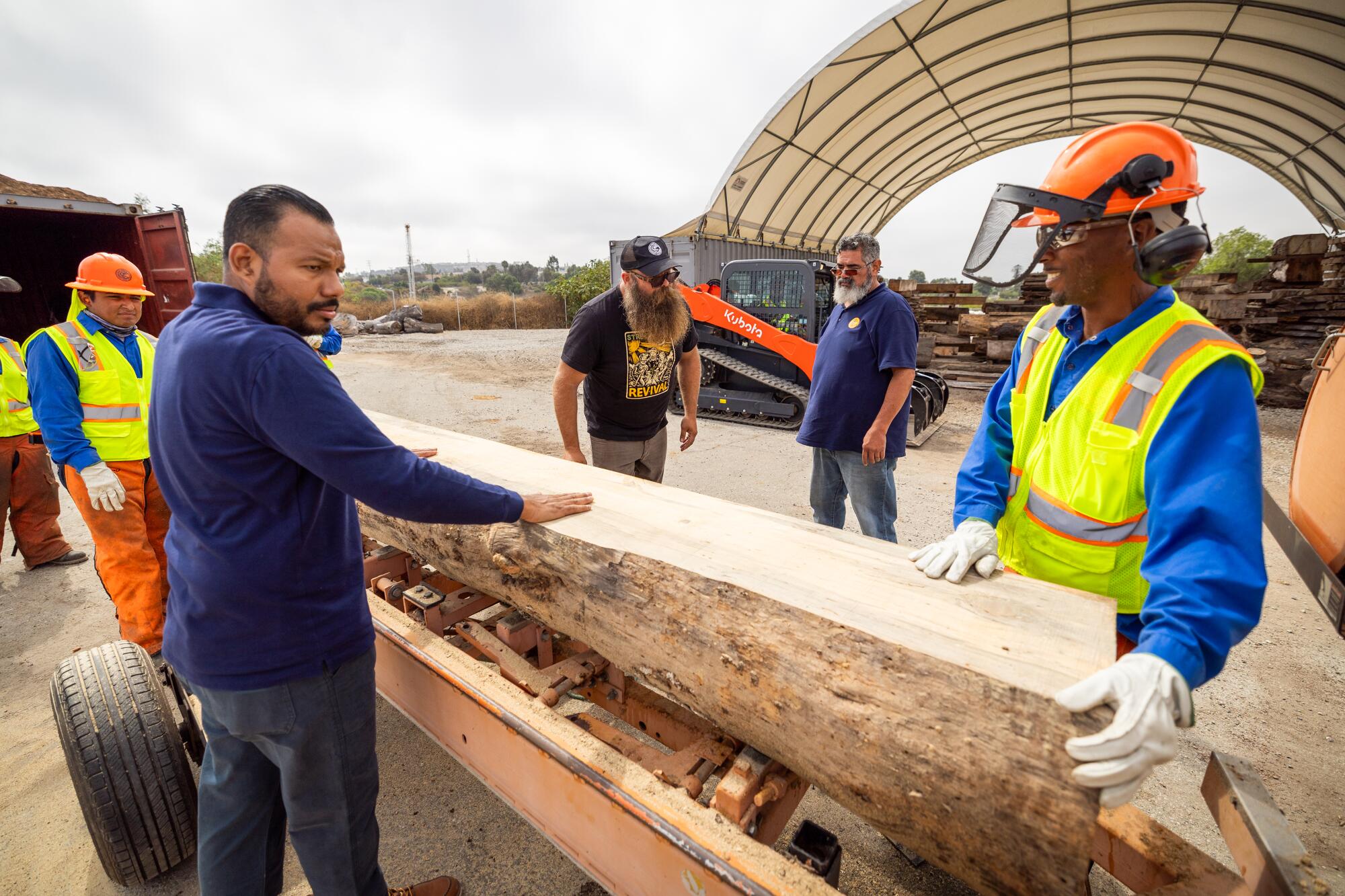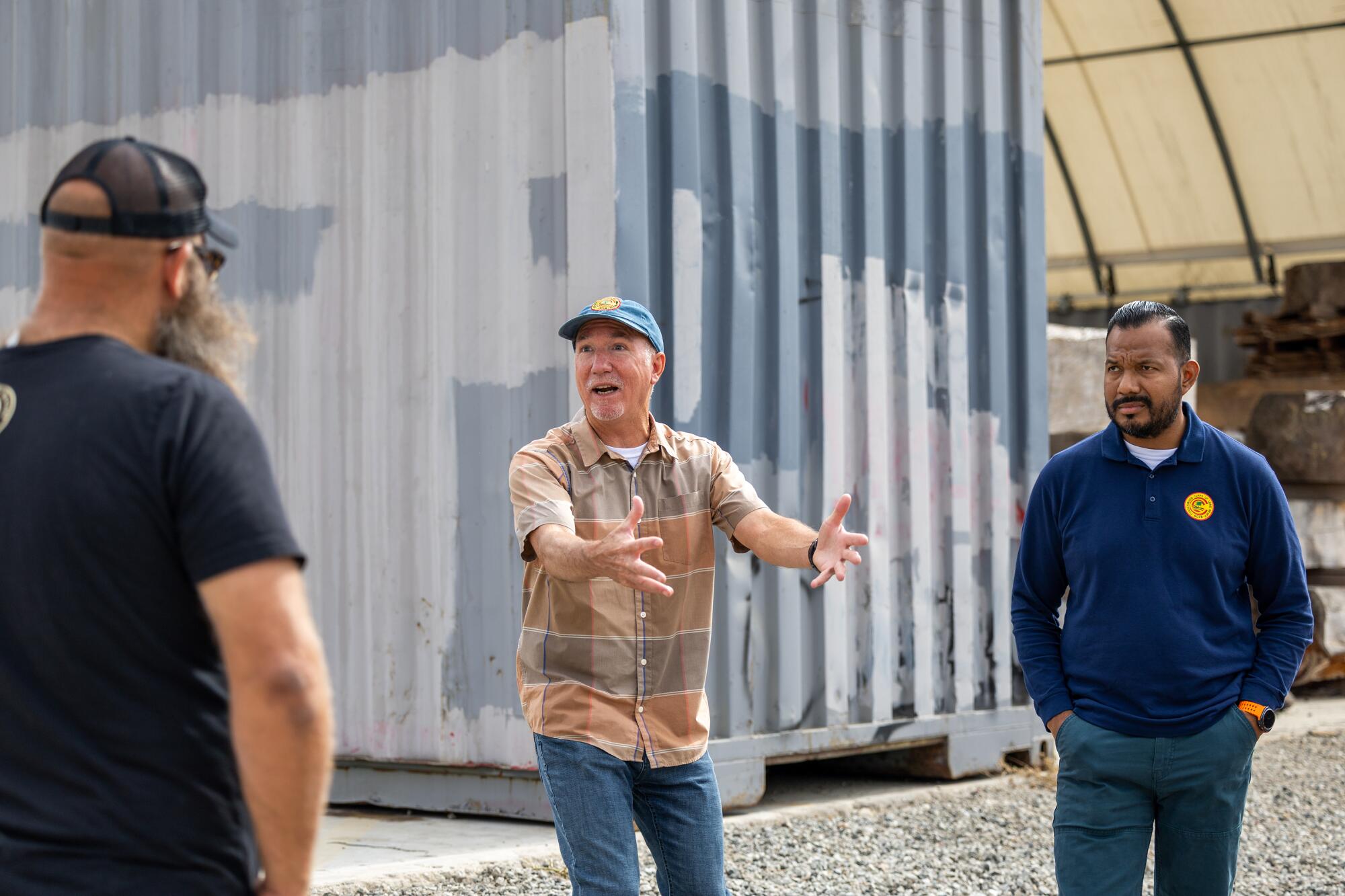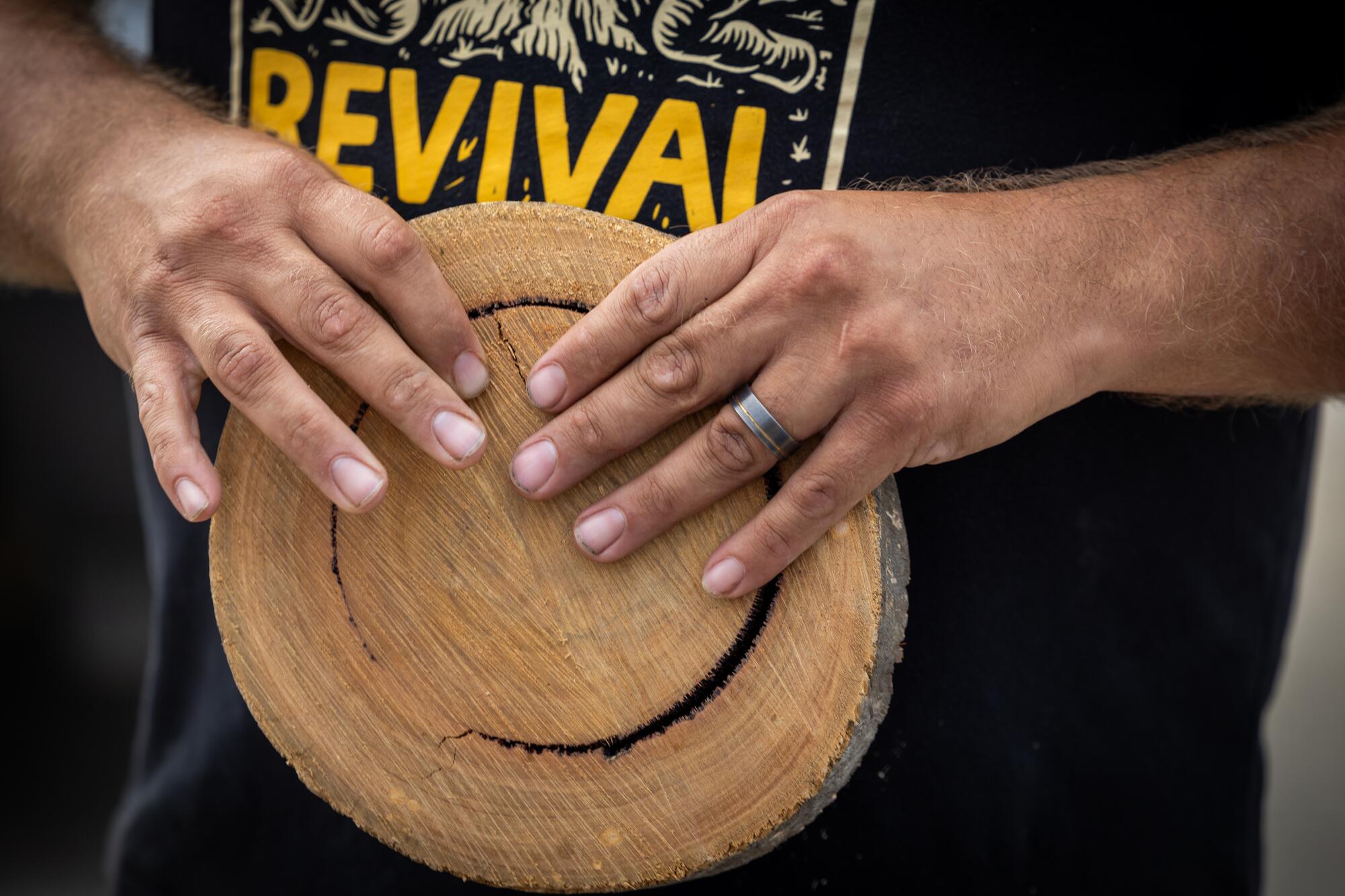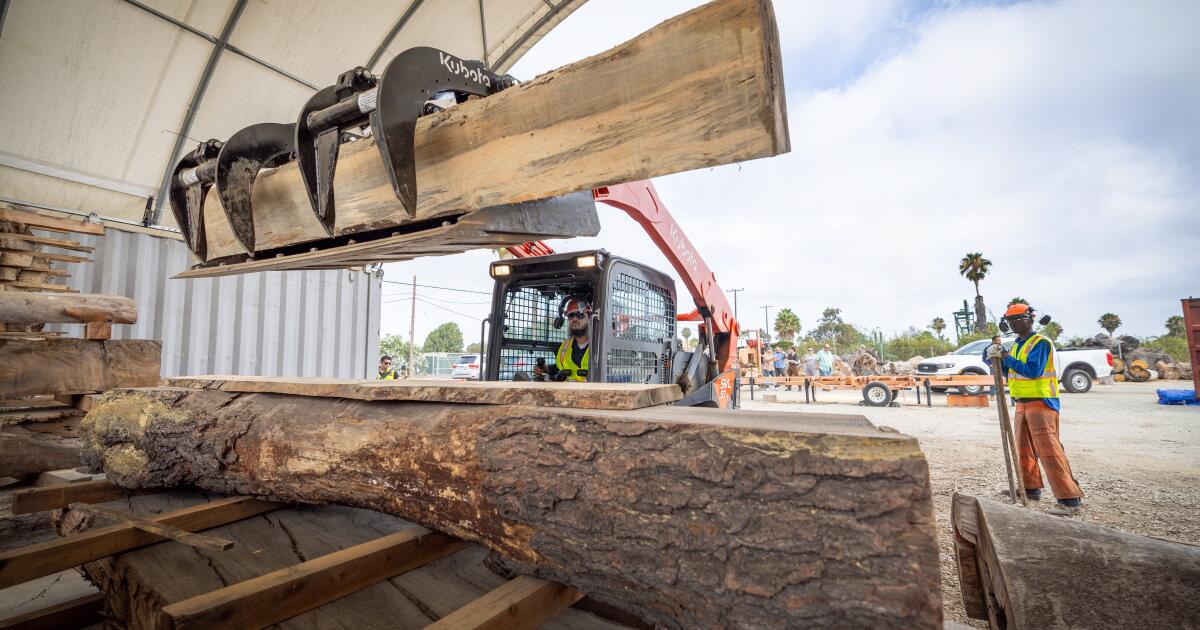To stop California’s 6 million urban trees from knocking out power lines, crashing through houses, or lying across streets when they die, humans have to intervene.
This week, a handful of arborists and Conservation Corps of Long Beach members gathered at a scrappy plot of land in the corner of a city park to do just that.
Early in the morning, corps members used a construction vehicle to grab one of the dozens of logs from under the shade structure and drop it onto the giant orange wood milling machine.
Conservation Corps of Long Beach worker Pablo De La Garza mills a large piece of wood at a lumber yard at Willow Springs Park in Long Beach.
(Allen J. Schaben / Los Angeles Times)
“You guys know what’s up — same routine,” Tito Leulusoo, the corps’ staff supervisor, called out to the group. “Should be easy. Let’s get it.”
The saw whirred to life. Corps members slowly, cleanly sliced bark from one side of the log. This piece of wood, once a thick eucalyptus tree living in the city, will one day become a bench — perhaps in one of Long Beach’s urban parks.
It’s the seedling of a vision the corps dreamt up just a few years ago. The corps has been planting trees since its inception in 1987, and now it wants to take care of the trees after they die, turning them into usable lumber for houses, desks, benches, sculptures — you name it.
“The only limit is your imagination,” said John Mahoney, an Urban Wood Manager at West Coast Arborists. “It’s humankind’s favorite building material, as far as you look into the past, as far as you can look into the future — it’s the warmth of wood.”

The Conservation Corps of Long Beach operates an urban lumber mill in a city park. Pictured from left are Pablo De La Garza, Javier Valladares, John Mahoney, J.J. Ortega and Maurice Lopez at Willow Springs Park in Long Beach.
(Allen J. Schaben / Los Angeles Times)
Dan Knapp, the executive director of the Conservation Corps of Long Beach, hopes to see the program grow into something much bigger. Right now, they’re working on and off with some borrowed equipment, but Knapp wants to see a crew of corps members dedicated to the project full time, with their own mill and kiln to dry the wood, and a storefront to sell it — all located on the same plot.
For every tree the corps mills, it hopes to plant two.
The amount of lumber available in cities is no small quantity. Each year, more trees fall in cities than are harvested from national forests, and researchers estimate that urban trees could replace roughly 10% of the United States’ annual lumber consumption.
After the corps won a $1-million grant from Cal Fire in 2022 to get the program started, the corps immediately turned to one of the state’s longtime leaders in urban lumber: West Coast Arborists.

John Mahoney, left, urban wood manager of West Coast Arborists; Dan Knapp, executive director and chief executive of the Conservation Corps of Long Beach; and Javier Valladares, director of construction training, Conservation Corps of Long Beach, discuss the milling of dead urban trees recently.
(Allen J. Schaben / Los Angeles Times)
The organization quickly agreed to help the corps. The resource of urban lumber is vast. “It would be silly for us to think we could take it on, on our own,” Mahoney said. “It’s going to take everyone to grow this whole movement. … You can save the world as long as you don’t want credit.”
West Coast Arborists say their urban lumber has ended up in the homes of A-list celebrities (they’re not at liberty to name names), provided the bodies of acoustic guitars and appeared at the Los Angeles County Fair (as part of the show where a guy balances on a log rolling across a lagoon).
“You never hear where the wood was grown,” Mahoney said, “but for us, it’s just cool to think that trees grown in Long Beach are now in Architectural Digest … like what the heck, that’s so cool.”
Mahoney comes from a family of tree lovers, and he’s filled with fun facts about trees — from how fungi can dye wood any color of the rainbow to the proper way to calculate a tree’s age. (Always add five years to the ring count, the first few years get smushed together into the center of the tree, he said.)
During the milling session, Mahoney and a colleague gave pointers to corps members as they worked the behemoth milling machine.
For Knapp, the excitement over urban lumber isn’t just the environmental benefits — it’s the opportunity to reach young people who are unsure of how to move forward in life and provide them with employment and career development opportunities.

John Mahoney, urban wood manager of West Coast Arborists, holds a piece of wood cut by Conservation Corps of Long Beach workers.
(Allen J. Schaben/Los Angeles Times)
“We attract young folks, I think, in a key part of their lives,” Knapp said. “You can be a high school dropout. You can be formerly incarcerated. You can be all these things, and you’re coming to us.”
The corps provides members with opportunities to finish their GED, attend college or vocational school, and meet with employers.
“I was that typical story of where you’re on a bad path,” Leulusoo said. “The Corps steered me into the right path.”
High school hadn’t been working out for Leulusoo, who was born and raised in Long Beach. Some of his family members were in the corps, so he decided to join.
Both Marco Navarrete and Madisen Tanore joined the corps after starting their college education. They just couldn’t ignore the itch to get their hands dirty and have a direct impact on their community.
“The corps, they let you experiment with whatever you want.” said Navarrete, who grew up in L.A. He’s studying psychology but hopes to go into project management. “It’s something that’ll help me out here … whether it be with the corps, or anywhere in Long Beach, really.”
For some of the five corps members onsite, it was their first day at the yard. They had come from working on road construction, water irrigation and an assortment of other corps projects to spend the day with a down-to-business Leulusoo and giddy Mahoney to learn the art of wood milling.
The corps has even developed a 40-hour training program with West Coast Arborists designed to prepare corps members for entry-level jobs in the field. Knapp’s hope is, if they don’t end up with a job from West Coast Arborists, they can use their skills in sustainable logging in Southern California forests, which are becoming overwhelmed with flammable vegetation.

Long Beach Conservation Corps workers pose for a photo during a break from milling and stacking wood recently.
(Allen J. Schaben/Los Angeles Times)
Building an urban lumber project from the ground up isn’t easy — and if cities want to capitalize on the full 10% of lumber consumption that urban lumber can fill, it’s an even harder challenge.
First, cities need to know where the dying trees are. Lara Roman, a research ecologist with the Forest Service, said there are two approaches cities can take: proactive and reactive.
“Reactive management is when all there is capacity to do is just respond to the latest emergency, and that is generally viewed, in urban forestry, as not the ideal system,” said Roman. “The ideal system would be, they’ve already got an up-to-date inventory and know where all the trees at most risk are.”
An inventory of all the trees in a region allows the city to send crews to clear at risk trees when an intense storm is looming or remove a certain species of tree that’s susceptible to a pest marching its way across the country toward Southern California.
But these inventories are difficult and costly to make and maintain. “Doing a tree inventory is very very expensive. You have to pay somebody to go walk every single street and measure every single tree,” said Natalie Love, who helped compile inventories into a database of 6 million urban trees in California as a researcher at California Polytechnic State University. “It’s a lot of manual labor.”
Even if organizations get word of a downed tree, preserving it for lumber processing takes additional care, and not all trees are still in shape to be used as lumber, especially if they died from disease or pests.
In that case, it’s typically chipped into mulch and composted, since California bans residents (including companies and the government) from sending dead trees to landfills.
However, this negates one of the key benefits of urban trees: They gather carbon from the atmosphere and store it in their wood.
“Carbon sequestration of urban trees is very short lived,” Love said. “If a tree is up for 30 years, that means it has 30 years of carbon sequestration, but if the city comes and chops it down and turns it into wood chips, and then those wood chips rot, that carbon then just goes back into the atmosphere.”
Yet if arborists use the chipped trees as mulch to support gardens, new trees or other plant life, they can still keep the carbon out of the air.
“Mulch is awesome,” said Mahoney, launching into another tree fact. “What’s the highest end use of a tree?” he said, referring to which end-of-life use sequesters the most carbon. Turns out mulch is second to lumber, with firewood in third and landfills in dead last.
“Am I anti-mulch? No. Not every tree is good for lumber,” Mahoney said. In urban lumber, “we’re basically sorting the pearls out.”
Newsletter
Toward a more sustainable California
Get Boiling Point, our newsletter exploring climate change, energy and the environment, and become part of the conversation — and the solution.
You may occasionally receive promotional content from the Los Angeles Times.
